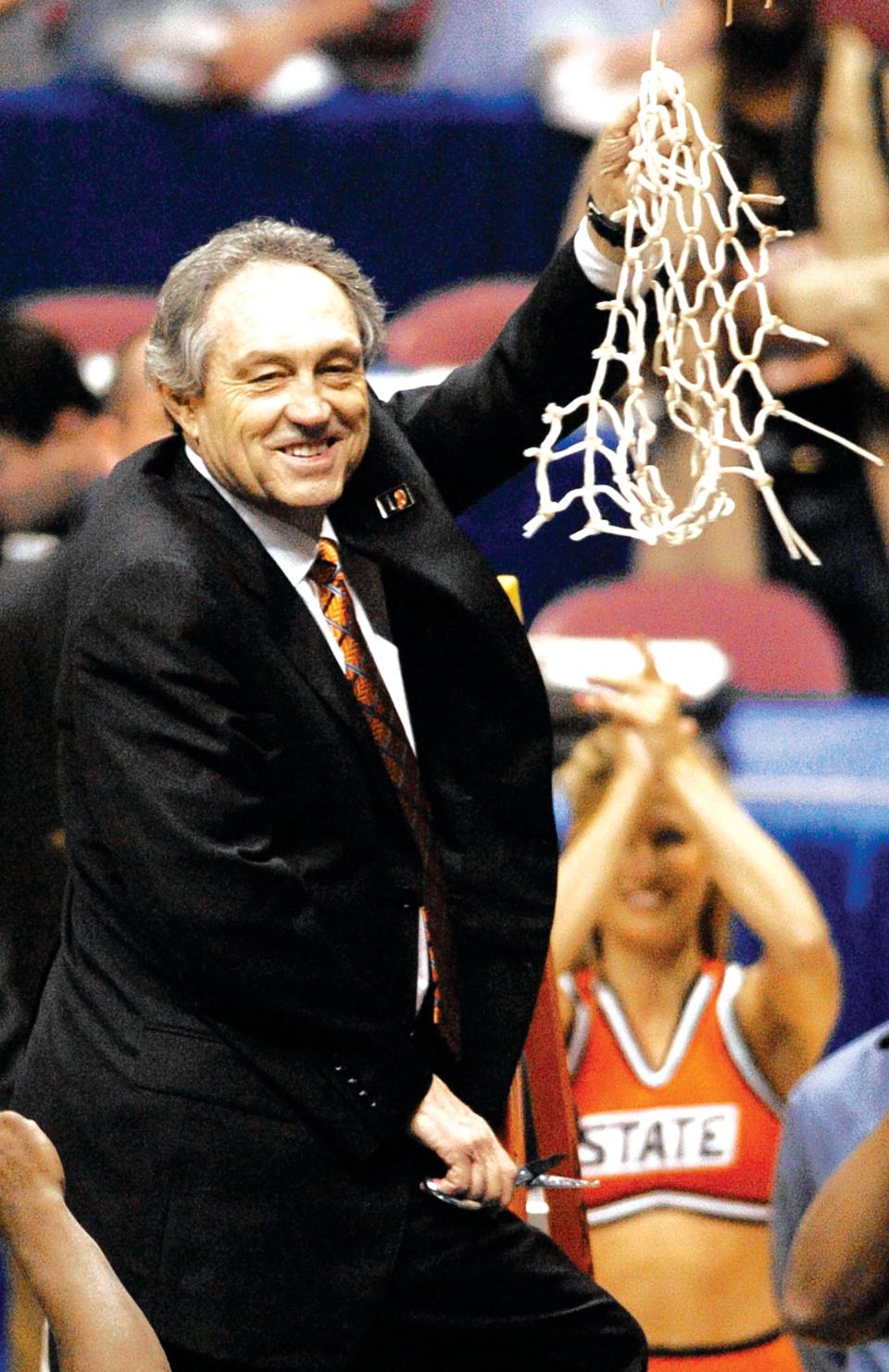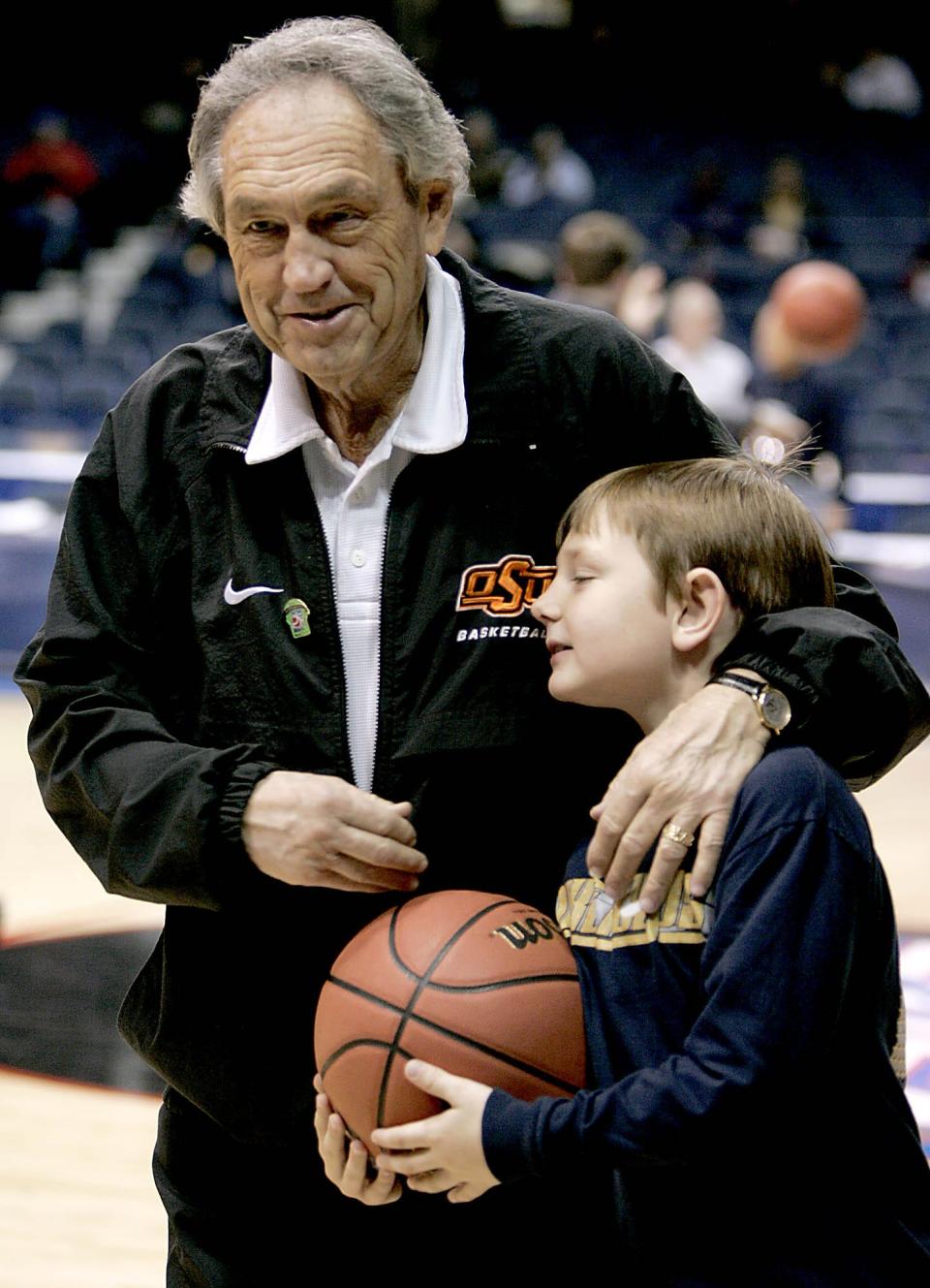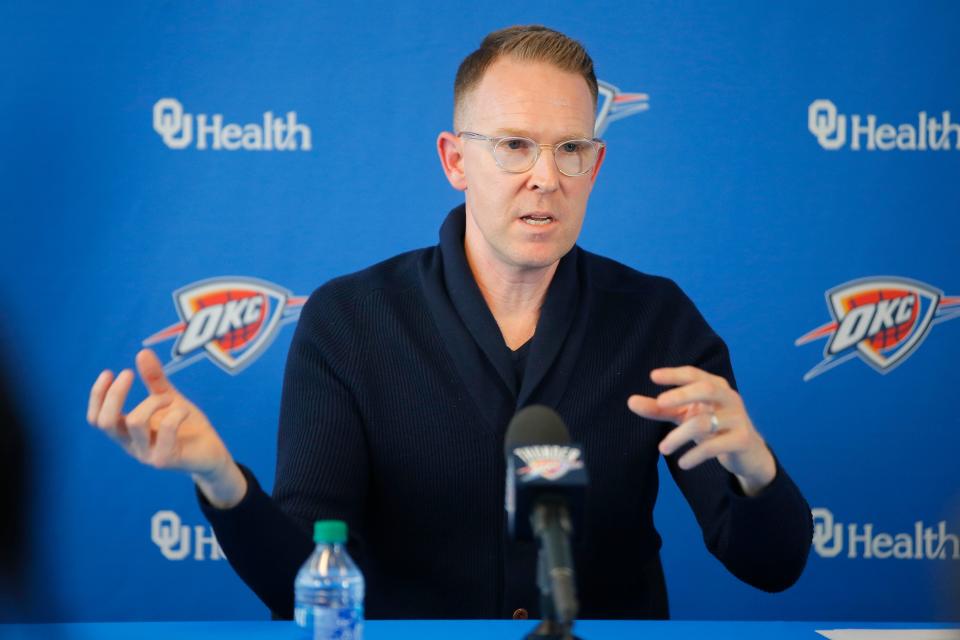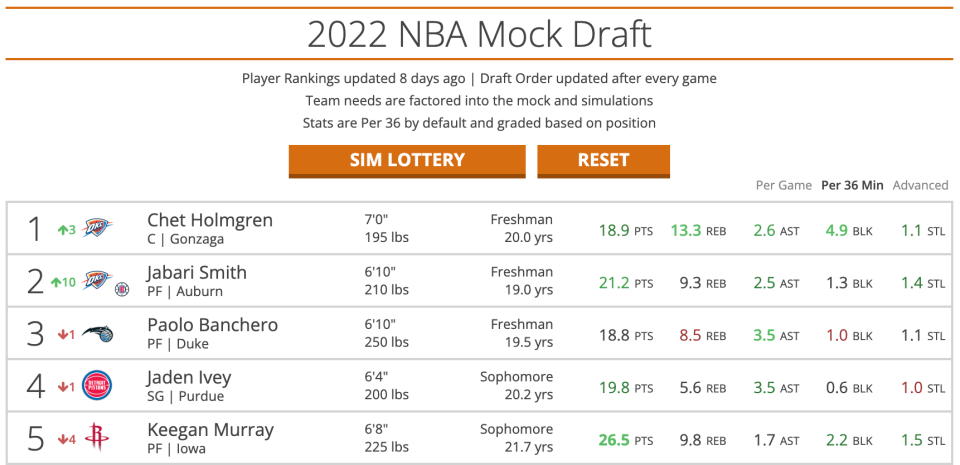Tramel's ScissorTales: Eddie Sutton was pre-portal king of transfers with Oklahoma State basketball
Thirty-two springs ago, OSU hired Eddie Sutton as basketball coach, and Sutton’s first recruit was, fittingly, a transfer.
A backup point guard who had played for Sutton at Kentucky but had sat out the previous season, which Sutton had also. At UK, that point guard played sparingly as a freshman but was a valuable backup his sophomore season, averaging 4.7 assists and 5.9 points a game.
Fellow by the name of Sean Sutton.
OK, Eddie Sutton had an in on that recruit.
But as the transfer portal explodes in 2022, in both football and basketball and most every sport, maybe it’s time to look back at Sutton’s use of transfers in building Cowboy basketball into a national brand.
There was no portal, just word of mouth. There was no immediate eligibility, at least in most cases; players were forced to sit out a season if transferring from a four-year institution to a Division I school.
'This guy doesn't get out': How Zach Ehrhard, with lessons from Wade Boggs, is adding spark to OSU baseball

The transfer culture was nothing like the chaos we see today. But Sutton had an eye for talent and a notion for fit and he knew a lot of people and he knew how players might be able to function at a much higher level than perhaps their previous coaches knew.
Roll call from those glorious Sutton teams:
► Sean Sutton, who started at point guard on two straight Sweet 16 teams (1991, 1992) and averaged 11.0 points and 4.4 assists while shooting 44.4% from 3-point range and 49.3% overall.
► Brooks Thompson, who had been a good player at Texas A&M and became a Big Eight standout in Stillwater, averaging 15.8 points and 5.4 assists in two seasons, while shooting 43.1% from 3-point range. Thompson played four seasons in the NBA.
► Von Bennett, a Stillwater High School graduate who played one year for Don Haskins at Texas-El Paso, then transferred to OSU and played his senior year for Sutton, averaging 8.2 points and 4.9 rebounds, mostly as Big Country’s backup in 1992-93.
► Scott Pierce, a power forward who started 18 games over two seasons at Illinois but transferred to OSU and became a starter on the 1995 Final Four team.
► Jerome Lambert, a center who had a monster year as a Baylor center in 1993-94 (18.5 points and 14.8 rebounds a game), then came to OSU and in 1995-96 averaged 13.0 points and 6.6 rebounds, while shooting 54.4% from the field.
► Power forward Maurice Robinson, a starter at Florida State, transferred to OSU and over two seasons, 1995-97, averaged 8.9 points and 4.2 rebounds, while shooting 55.9% from the field.
► Shooting guard Marlon Dorsey, who transferred from Mississippi State and over two OSU seasons averaged 5.8 points and shot 39.4% from 3-point range.
► Center Brett Robisch, who in two years at Illinois played sparingly but who in Stillwater started two seasons and became a star as a senior, averaging 15.4 points and 8.2 rebounds on a team that reached the second round of the NCAAs.
► Point guard Doug Gottlieb, who started as a freshman at Notre Dame but was dismissed from the team and landed in Stillwater, where in three years (1997-00) he made 84 starts and averaged 8.2 assists per game.
► Shooting guard Glendon Alexander, who was a good player at Arkansas and an even better player in Stillwater, averaging 9.4 and 11.7 points per game for two excellent OSU teams, 1998-99 and 1999-00. Alexander shot 42.1% from 3-point range as a Cowboy.

► Point guard Victor Williams, who transferred from Illinois State and became a three-year Cowboy mainstay, making 90 starts and averaging 13.4 points and 3.6 assists.
► Point guard John Lucas, who transferred from Baylor and was eligible immediately due to the Dave Bliss scandal. Lucas became an all-time Cowboy hero; the 2004 Big 12 player of the year led OSU to the Final Four and over two seasons averaged 16.3 points and 4.3 assists, while shooting 41.3% from 3-point range.
► The Graham twins, Joey and Stevie, transferred from Central Florida, and became huge for two of the best OSU teams ever, including the 2004 Final Four team. Joey was the 2005 Big 12 player of the year and averaged 15.0 points and 5.7 rebounds a game, while shooting 54.9% from the range. Stevie mostly came off the bench but still made the NBA; at OSU, he averaged 4.6 points a game and shot 48.9% from the field.
► Shooting guard Daniel Bobik transferred from Brigham Young and made 63 starts in 2003-04 and 2004-05 combined, averaging 7.0 points and shooting 40.5% from the field.
Count them up. That’s 15 impact transfers in Sutton’s 16 seasons as coach. Most of them starters. Some of them stars.
So would a coach like Sutton fare better or worse in today’s portal culture?
Two ways to look at it. A) Sutton knew the ins and outs of transfers and how to best handle them; he would be even more successful with access to immediately-eligible transfers; B) Sutton’s edge would be less, since every coach now is (or should be) on the portal train, and transferring players’ options have expanded to the likes of Kentucky and North Carolina, not just OSU and Iowa State.
I tend to think B, that the portal is mostly just the college basketball world catching up to Sutton and his propensity to give players a second chance and a fresh start.
But either way, the transfer game worked famously for Sutton. Five of his rotational players off the 2004 Final Four team were four-year transfers (including Jason Miller from North Texas).
From Sean Sutton to the Graham twins, Eddie Sutton rebuilt OSU basketball with transfers. He was ahead of his time.
More: Nick Collison to represent OKC Thunder at 2022 NBA Draft Lottery

More: What OKC Thunder fans should know about the 2022 NBA Draft Lottery
The List: Longest odds to win NBA lottery
The NBA Lottery arrives Tuesday night, and for the second straight year, the lottery is paramount to the Thunder fortunes.
We’ve focused extensively on the Thunder’s chances of getting a top-four pick. But shoot the moon and hope for the No. 1 pick. The Thunder has a 14% chance of getting the No. 1 pick, counting its own 12.5% chance and the Clippers’ 1.5% chance, since OKC owns Los Angeles’ pick.
Fourteen% doesn’t sound like great odds. But since 1990, when the NBA went to a weighted lottery, 10 teams have secured the No. 1 pick with odds less than 10 percent:
1.5% 1993 Magic: Chris Webber. Traded on draft night to the Warriors, for Penny Hardaway and first-round picks that became Vince Carter, Mike Miller and Todd Fuller. Webber was a star, but that was a heck of a trade for Orlando.
1.7% 2008 Bulls: Derrick Rose. The ultimate lottery luck returned Chicago to contending status.
1.7% 2014 Cavaliers: Andrew Wiggins. Cleveland traded Wiggins that summer for Kevin Love; probably not a good trade, but the Cavs got a 2016 NBA title out of the deal.
2.8% 2011 Cavaliers: Kyrie Irving. Cleveland got the pick in a trade with the Clippers. The Cavs sent out Mo Williams and Jamario Moon; Cleveland got back an aged Baron Davis and the pick that became No. 1.
4.4% 2000 Netropolitans: Kenyon Martin. Perhaps the worst NBA Draft of all time. The best players out of that draft were Martin, Hedo Turkoglu, Mike Miller, Jamal Crawford or Michael Redd. Take your pick.
5.3% 2007 Trail Blazers: Greg Oden. Portland won the lottery, with Seattle settling for the No. 2 pick. The Sonics took Kevin Durant. Thank you, Blazers.
6%: 2019 Pelicans: Zion Williamson. Ja Morant has turned into the transcendent superstar of that draft.
6.3%: 2005 Bucks: Andrew Bogut. A solid pro, Bogut never was a star. But Chris Paul was; CP3 went No. 4.
8.8% 2006 Raptors: Andrea Bargnani. It wasn’t a great draft. Bargnani wasn’t a bad player – 10 years in the league; 14.3 points per game – but Toronto would have been better off with LaMarcus Aldridge, who went No. 2.
8.9% 2002 Rockets: Yao Ming. A great player who was hurt too much.
9.4% 1995 Warriors: Joe Smith. The No. 1 pick is not as important as the No. 1 talent eye. Rasheed Wallace went fourth in this draft. Kevin Garnett went fifth.
More: Where might OKC Thunder land in NBA Lottery? Let's take a spin on Tankathon.

More: Tramel: BYU's ascension to the Big 12 started with the revered LaVell Edwards
BYU's NCAA softball streak ends
Brigham Young softball had made 16 straight NCAA Tournaments; 2005-19, plus 2021 (COVID wiped out the 2020 season). But the Cougars’ streak ended Sunday, when the NCAA softball committee bypassed BYU.
And the Cougars can’t wait to get to the Big 12. BYU will join the Big 12 in summer 2023, meaning the Cougars will play Big 12 softball in 2024.
“We are deeply disappointed we did not receive a bid to the NCAA tournament,” BYU coach Gordon Eakin said. “This year’s team is playing great softball and deserved a shot. We will respect the committee’s decision and use it as a motivator to get better going forward.”
Credit Eakin for taking the high road. But BYU has to look longingly at Power 5 Conference status. The Big 12 is not a softball behemoth, at least not past OU and OSU, but it trumps the West Coast Conference, which has held back BYU.
BYU and Loyola Marymount tied for the WCC championship, each with a 13-2 record. LMU won the tiebreaker by taking two of three from the Cougars, and the Lions were awarded the NCAA’s automatic berth.
BYU, 42-10, finishes the year on a 17-game winning streak. BYU went 6-3 against Power 5 teams this season, with the losses coming to 13th-ranked Oregon, 17th-ranked Tennessee and 23rd-ranked Arizona State.
But the Cougars ranked just 52nd in the Ratings Percentage Index. They were dragged down by the other four teams in the West Coast Conference – 21-30 Santa Clara, 18-34 San Diego, 16-31 Saint Mary’s and 12-37 Pacific.
Meanwhile, 12 of the Southeastern Conference’s 13 softball teams made the NCAA Tournament, including Texas A&M, which will play in OU’s regional with a 29-26 overall record, a 6-12 SEC record and a No. 40 RPI ranking.
Such is life as a mid-major, in a variety of sports. The system is set up to favor the power-conference schools.
And soon enough, BYU will join those ranks.
The OU and Texas departures to the SEC will weaken Big 12 softball, but the additions of BYU, Central Florida and Houston will help fill the void. UCF is having a breakout season, with a national No. 16 seed. The Knights are hosting a regional this weekend and could be in Norman for a Super Regional next week.
Houston was 27-27 overall and 8-9-1 in the American Conference, good for fourth place. Three American teams made the NCAA field – UCF, Wichita State and South Florida.
The additions of UCF and BYU will help Big 12 softball. And Big 12 softball will most definitely help BYU.
More: Why OKC Thunder players are owed big bonus check due to NBA salary cap oddity
NBA conference finals predictions
The NBA’s conference finals are set, after two stunning Game 7s in the conference semifinals.
Dallas’ 123-90 rout of Phoenix was unbelievable. Literally. Not to be believed. The Mavericks hammered the top-seeded Suns early and often. The game was not as close as the score indicated, and the 33-point margin was the NBA’s most lopsided Game 7 home loss since 1948, when the Philadelphia Warriors beat the St. Louis Bombers 85-46 in the Basketball Association of America (NBA forerunner) semifinals. The Bombers folded two years later. I assume the Suns will stay in business longer than that.
Boston’s 109-81 home victory over Milwaukee was the opposite – much closer than the score indicated. The squads went toe-to-toe for six games, playing fantastically close dramas, and Milwaukee was still in Game 7 until a fourth-quarter barrage blew it open.
So now we’re down to the NBA’s final four. Let’s get to the predictions:
Celtics vs. Heat: Miami has homecourt advantage, but that won’t count for as much, since Miami fans don’t arrive until the second quarter. This will be a trench battle; both play elite defense, though Boston’s is better since its mid-season turnaround. Both teams have two superstars, but the Celtics’ duo is the prototype of what modern NBA teams need. Tall wings who can shoot 3-pointers (Jayson Tatum and Jaylen Brown). That should trump Miami alley-fighters Jimmy Butler and Bam Adebayo. Boston in six.
Mavericks vs. Warriors: Both teams were in tight, tough conference semifinals. Golden State survived Memphis in six games. Dallas took 273 3-point shots in its seven games against Phoenix; that’s 39 per game. Thirty-nine! And the Mavericks made 39.9%. Is it possible to beat a team that shoots 39 3-pointers a game and makes 40%? I don’t think so. The Warriors took 39.5 3-pointers a game against Memphis but made just 34.2%. If Dallas outshoots Golden State by five percentage points on the deep ball, the Mavericks are Finals-bound. But I figure Dallas will shoot a little worse, the Warriors a little better, so let’s go Golden State in seven.
More: Tiger Woods, Southern Hills have both changed plenty since 2007 PGA Championship
Mailbag: Phil Mickelson
I ran a list last week of the most notable falls from grace among athletes. It wasn’t my list, but it still drew a suggestion.
Tony: “I was a bit surprised Phil Mickelson wasn't on your list of popular athletes whose popularity cratered. Certainly, Mickelson was a fan favorite across the U.S. and across the pond -- at least at the (British) Open. Tiger cratered but had time to recover somewhat. Though, as you said, he's never been as popular as he was before the publicized infidelity. I can't see Michelson climbing back up that ladder. First, he doesn't have as many good playing days ahead of him as Tiger did. Second, if his financial situation with enormous gambling debts is true, then he may have no choice in his mind but to take the money from the Greg Norman/Saudi backed league. If that happens, he will finish his career in relative obscurity and on the permanent outs with the PGA.”
Tramel: By all means, Mickelson belonged on the list. It’s difficult to fathom how far Mickelson has fallen. A year ago, Mickelson won the PGA at age 50, further solidifying himself as an all-time great.
Now, he’s a pariah. A guy with a clear gambling addiction who acknowledges the dangers of going into business with the Saudis but sees it as leverage against the PGA Tour, which whom he is at war.
America is largely forgiving of its celebrities, but Mickelson has a long way to go.
Berry Tramel: Berry can be reached at 405-760-8080 or at btramel@oklahoman.com. He can be heard Monday through Friday from 4:40-5:20 p.m. on The Sports Animal radio network, including FM-98.1. Support his work and that of other Oklahoman journalists by purchasing a digital subscription today.
This article originally appeared on Oklahoman: Oklahoma State basketball: Eddie Sutton transfer king before portal

